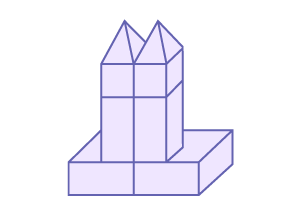E1.3 Construct and describe two-dimensional shapes and three-dimensional objects that have matching halves.
Activity 1: Memory Game
Material
- series of images of objects in the environment, half of which are a set of symmetrical shapes
- glue
- construction paper
Present a series of images of objects found in the environment. Half of the images should be symmetrical.
Ask students to sort the images according to whether or not they show symmetry.
Once the sorting is complete, ask the following questions:
- Why do you say that this illustration is symmetrical?
- Why do you say that this illustration is not symmetrical?
Use these images to create a memory game.
Glue the images onto construction paper to make game cards.
Make the game available to students in a learning centre.
Give the following explanations:
- The game is played in groups of two, three, or four students.
- All cards must be placed on the table, face down.
- A student turns over two cards.
- If the two cards are both symmetrical or non-symmetrical shapes, the student removes them from the deck, sets them aside, and turns over two new cards. If they don't match they are turned face down again. Then it is another student's turn to play.
- The student who accumulates the most cards wins.
Source: translated from Guide d’enseignement efficace des mathématiques de la 1re à la 3e année, Géométrie et sens de l'espace, p. 81.
Activity 2: Building a Symmetrical Structure
Material
- geometric three-dimensional objects
- sheets of 28 cm by 43 cm construction paper
Instructions
Form groups of two students.
Give each group three-dimensional objects and a large sheet of paper divided in half.
Describe to students how they are to build a symmetrical structure by doing the following:
- one person places a three-dimensional object on one side of the paper;
- the other person places a corresponding three-dimensional object on the other half of the paper; and
- they alternate roles until the structure is completed.

Source: translated from Guide d’enseignement efficace des mathématiques de la 1re à la 3e année, Géométrie et sens de l'espace, p. 81-82.
Activity 3: Hunting for Symmetrical Objects
Material
- blank sheets of paper
- coloured pencils
Instructions
Form groups of two students.
Give the following instructions:
- go around the classroom and look for symmetrical objects;
- write the name or draw each of the symmetrical objects on your paper.
Examples of Success Criteria
The student:
- recognizes shapes that are symmetrical;
- describes what is the same on both sides of the line of symmetry.
Follow-up at Home
At home, the student may:
- fold their clothes to show the line of symmetry;
- find objects that have symmetry.
Source: translated from Guide d’enseignement efficace des mathématiques de la 1re à la 3e année, Géométrie et sens de l'espace, p. 82.
Activity 4: Am I Still Symmetrical?
Instructions
- Draw, on a sheet of paper, several triangles, rectangles, squares, rhombuses, and pentagons of different sizes and orientations (note that some triangles should be isosceles or equilateral).
- Give each student a copy of the sheet.
- Ask students to draw the line or lines of symmetry using the Mira.
Intervention
Ask questions such as:
- What are these shapes called? How do you know?
- Are triangles always symmetrical? rectangles? squares? rhombuses? pentagons? Justify your answer.
- What can you tell us about symmetrical shapes?
Source: translated from Guide d’enseignement efficace des mathématiques de la 1re à la 3e année, Géométrie et sens de l'espace, p. 51.
